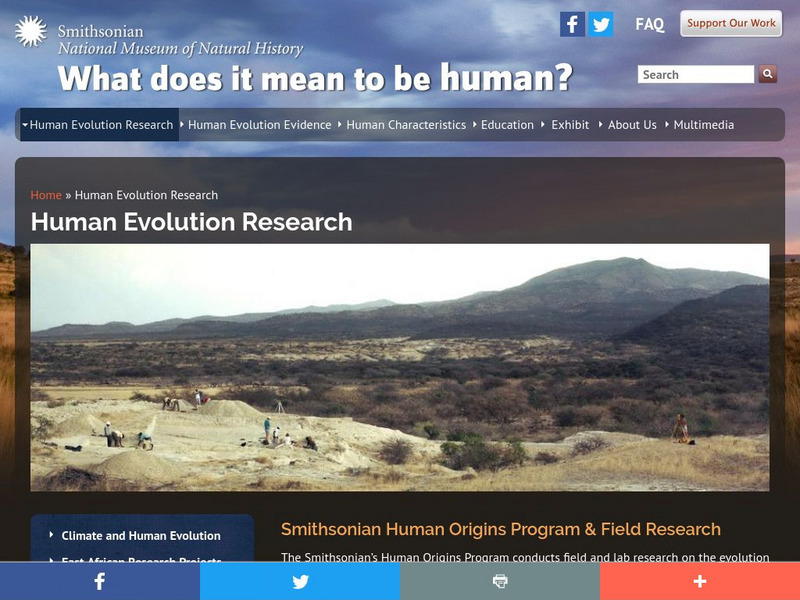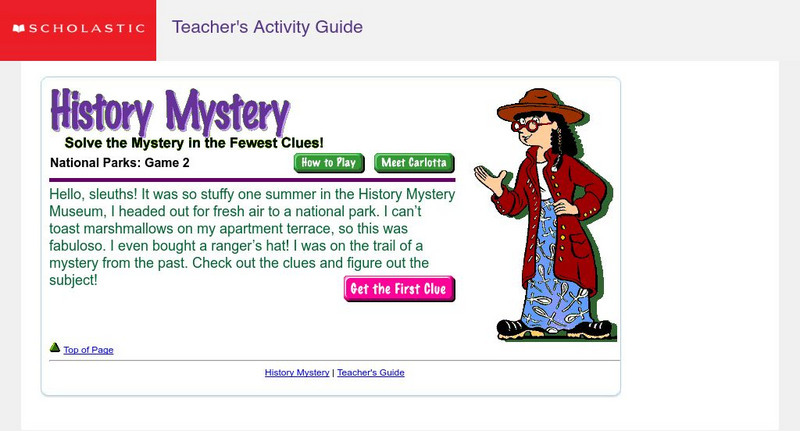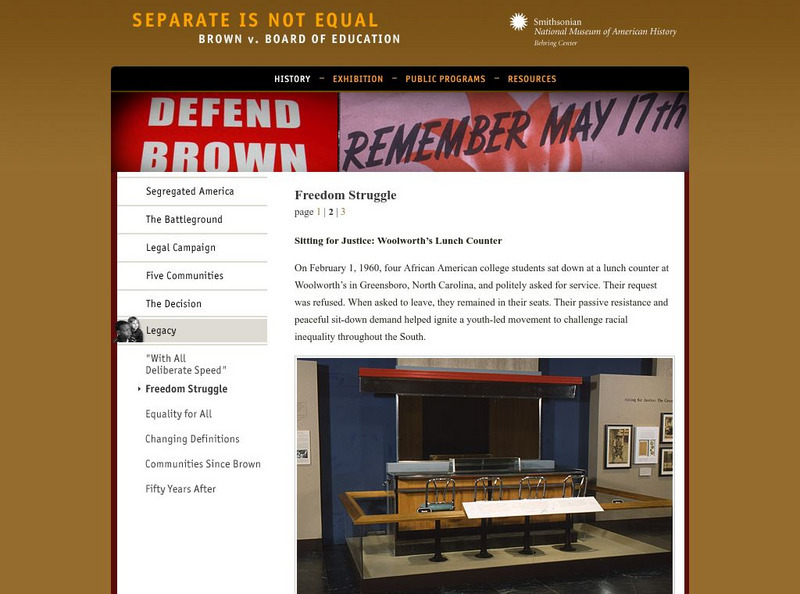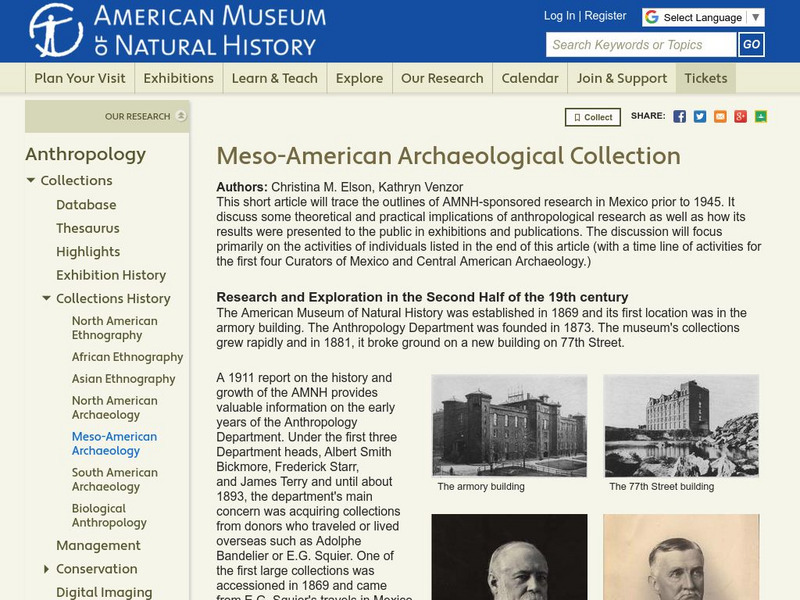Smithsonian Institution
National Museum of Natural History: What Does It Mean to Be Human: Human Evolution Research
Research continues to discover evidence left behind by prehistoric man. Discover the climate effects on human evolution and explore how the adaptable survived. The Asian and East African Research Projects in Kenya are described. You,...
Smithsonian Institution
National Museum of Natural History: What Does It Mean to Be Human, Human Characteristics
Explore walking upright, tools and food, bodies, brains, social life, language and how humans ultimately changed the world. Excellent charts, pictures and videos accompany easy-to-understand text on the earliest humans.
Smithsonian Institution
National Museum of Natural History: Asustralopithecus Afarensis
This resource offers an excellent definition of the species, Australopithecus afarensis.
Smithsonian Institution
National Museum of Natural History: Does Our Background Shape Our Thinking About Environmental Issues? [Pdf]
A lesson where students explore the positive and negative impacts of human activities on the environment today and in the distant past, and examine how attitudes towards the environment might be shaped by one's experiences growing up....
Smithsonian Institution
National Museum of Natural History: Written in Bone: Forensic Files of the 17th Century Chesapeake
This very thorough site will fascinate those interested in forensic anthropology. You will learn what you can read from bones, how a face can be reconstructed from a skull, clues you can read from a burial, and about forensic cases both...
Smithsonian Institution
National Museum of Natural History: The Canela Indians
Journey to Brazil and visit the Canela Indians. Learn all about their culture and view artifacts and video footage.
Other
La Salle: Charles Wilson Peale at Belfield: "Your Garden Must Be a Museum" [Pdf]
This university site offers a profile of American artist/scientist/inventor, Charles Willson Peale. Points out his interest in gardens and natural history and includes a section of his "Your Garden Must be a Museum" speech.
The British Museum
British Museum: Egyptian Life
Students learn about a day in the life of two ancient Egyptian families. They also explore paintings to learn more about the life of a wealthy nobleman in ancient Egypt. Afterwards, they can play Senet, a popular Egyptian game.
Scholastic
Scholastic History Mystery: National Parks 2: The General Sherman Tree
Students try to guess the mystery subject Carlotta Facts, the History Mystery Museum's professor, is studying. They read the clues, do some online and offline research, and then attempt to identify the game's mystery subject, the General...
American Museum of Natural History
American Museum of Natural History: African Ethnography
The Anthropology Division's African collection is extensive in terms of geographic coverage. It includes North Africa, West Africa, and Madagascar, although its greatest concentration of material is from central and southern Africa. The...
Smithsonian Institution
National Museum of American History: Separate Is Not Equal: The Quest for Education
Part of a larger piece on Segregated America, this section focus is on the commitment and perseverance of African Americans in the post-Civil War South to overcome the obstacles standing in the way of an education. Offers teachers and...
Alabama Learning Exchange
Alex: Wandering Alabama
This lesson is a fun fact gathering mission! Alabama is rich in history, museums, natural and manmade attractions, and some just plain wacky attractions. Learners will work in collaborative groups to create a guide to sites in Alabama...
Carnegie Museum of Natural History
Carnegie Museum of Natural History: Lewis and Clark
This resource describes how Lewis and Clark described various animals two centuries ago.
Smithsonian Institution
National Museum of Natural History: Smithsonian Expeditions in Latin America
This site from the Smithsonian Institution gives information on expeditions of Smithsonian scientists to Latin America. The site has great pictures and gives a different perspective on the region.
Smithsonian Institution
National Museum of Natural History: Random Strategies in Archeology
Students participate in a three-part archeological interpretation activity. First, they learn the principles of archaeology and the importance of material culture, and then they question ideas and interpret artifact evidence. Finally,...
Smithsonian Institution
National Museum of Natural History: Canela Body Adornment
Among the Canela of Brazil, adorning the body enhances appearance, signals changes in social identity, and expresses culturally prescribed values. View vivid photos of the different cosmetic treatments men and women undergo.
Smithsonian Institution
National Museum of Natural History: Homo Habilis
This resource provides graphics, as well as explanation, of the remains of Homo habilis.
Smithsonian Institution
National Museum of American History: Jamestown, Quebec, Santa Fe: Three North American Beginnings
Explore the origins of Canada and the United States as Jamestown, Quebec, and Santa Fe celebrate their 400th anniversary.
Other
Museum of Un Natural Mystery: Great Pyramid of Giza
A synopsis of the history of the Great Pyramid of Khufu since its construction.
Smithsonian Institution
National Museum of American History: Separate Is Not Equal: Sitting for Justice: Woolworth's Lunch Counter
Read a brief description of the sit-in at the Woolworth lunch counter in Greensboro, North Carolina. This sit-in, passive and non-violent resistance to segregation laws, lasted for six months.
American Museum of Natural History
American Museum of Natural History: Meso American Archaeology
This short article will trace the outlines of AMNH-sponsored research in Mexico prior to 1945. It discuss some theoretical and practical implications of anthropological research as well as how its results were presented to the public in...
Other
Denver Museum of Nature and Science: Ancient Denvers
What did Denver look like millions of years ago? Find out the answer to this and see how it has changed over time. There is also a list of parks to visit in Colorado.
Smithsonian Institution
National Museum of American History: Feather Trade and the American Conservation Movement
The 19th century love for feather adornments led to a hue and cry by conservationists against the wholesale killing of birds. This site details the time, the feather trade, and the move to curtail it.
Smithsonian Institution
National Museum of Natural History: Homo Heidelbergensis
Informative page on the Homo heidelbergesis provides pictures of the fossil evidence.



![National Museum of Natural History: Does Our Background Shape Our Thinking About Environmental Issues? [Pdf] Lesson Plan National Museum of Natural History: Does Our Background Shape Our Thinking About Environmental Issues? [Pdf] Lesson Plan](https://d15y2dacu3jp90.cloudfront.net/images/attachment_defaults/resource/large/FPO-knovation.png)















